The Impact of Socioeconomic Class on Health and Social Care: An Essay
VerifiedAdded on 2023/01/11
|7
|1856
|69
Essay
AI Summary
This essay provides an in-depth analysis of the impact of socioeconomic class on health and social care, focusing on the UK context. It explores how factors such as poverty, employment, housing, and the environment influence individual health outcomes. The essay examines the negative cycle between poverty and health, highlighting the inaccessibility of healthcare due to financial constraints and high medical charges. It discusses the effects of housing on mental health and the risks associated with poor living conditions. Employment is presented as a crucial factor, with unemployment linked to increased health risks and limited access to care. The essay also emphasizes the importance of a supportive environment for mental and physical well-being, and inequality in healthcare access. The conclusion stresses the importance of government policies to address these issues and ensure equal healthcare access. The essay provides valuable insights into the complex interplay between socioeconomic factors and health, offering recommendations for improvement.
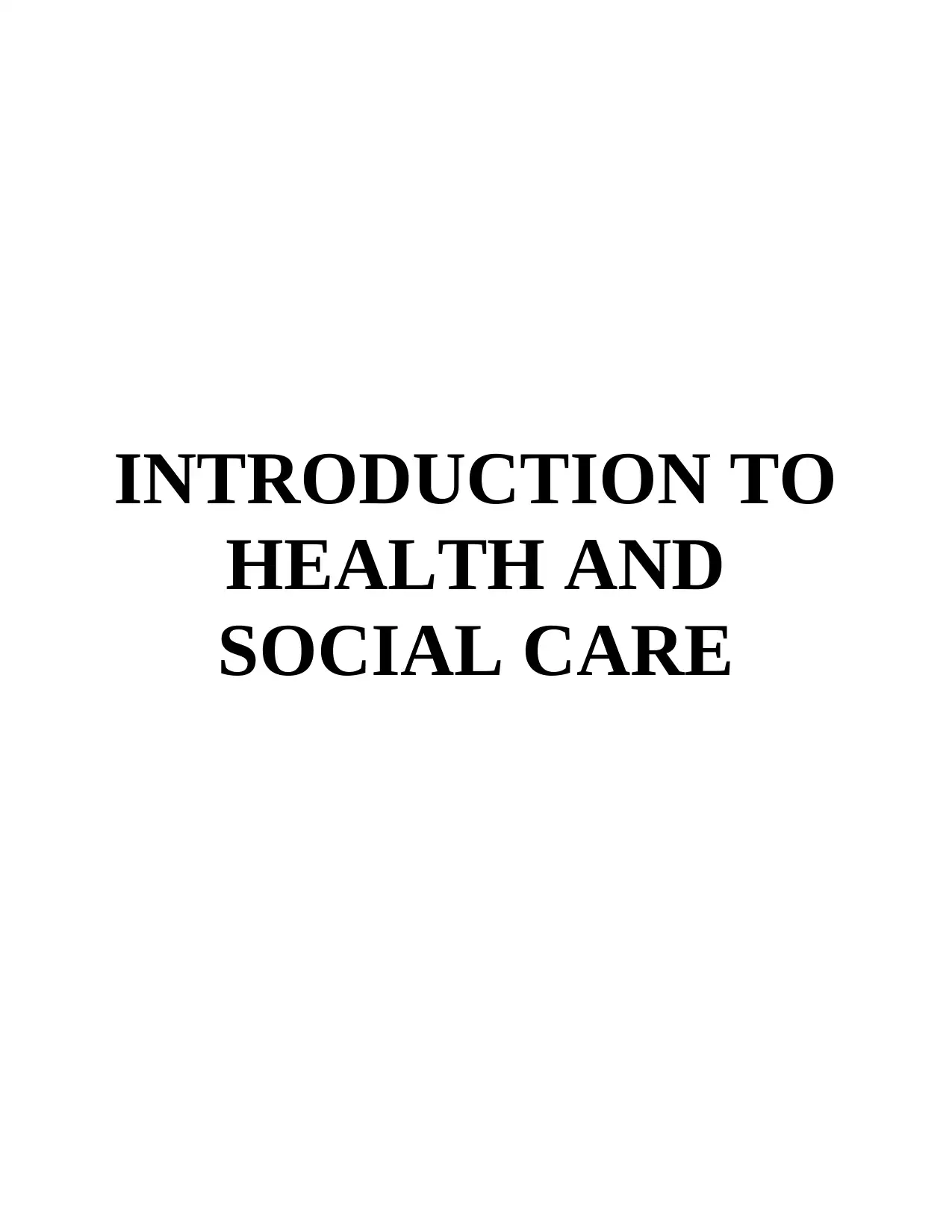
INTRODUCTION TO
HEALTH AND
SOCIAL CARE
HEALTH AND
SOCIAL CARE
Paraphrase This Document
Need a fresh take? Get an instant paraphrase of this document with our AI Paraphraser

Table of Contents
INTRODUCTION...........................................................................................................................1
MAIN BODY...................................................................................................................................1
CONCLUSION................................................................................................................................4
REFERENCES................................................................................................................................5
INTRODUCTION...........................................................................................................................1
MAIN BODY...................................................................................................................................1
CONCLUSION................................................................................................................................4
REFERENCES................................................................................................................................5
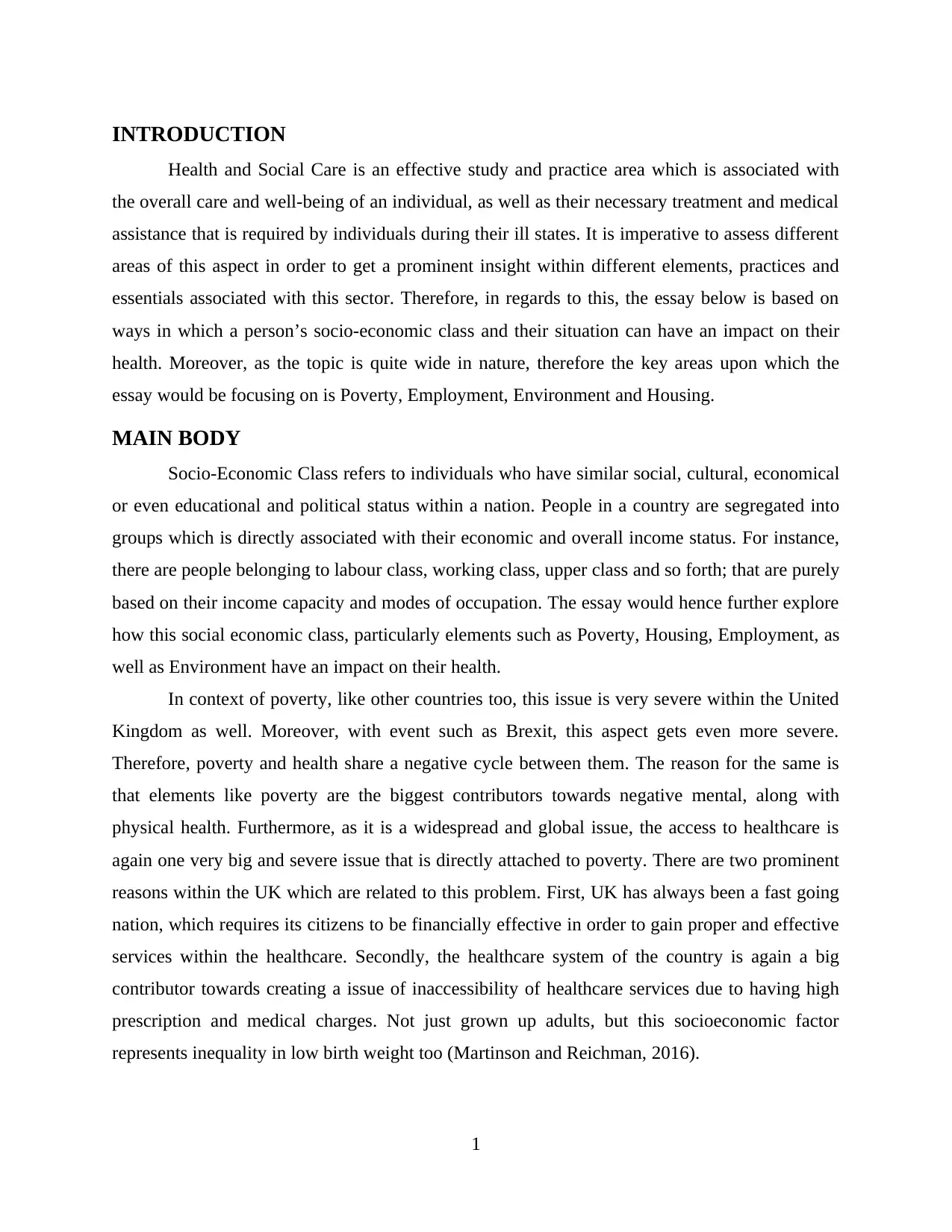
INTRODUCTION
Health and Social Care is an effective study and practice area which is associated with
the overall care and well-being of an individual, as well as their necessary treatment and medical
assistance that is required by individuals during their ill states. It is imperative to assess different
areas of this aspect in order to get a prominent insight within different elements, practices and
essentials associated with this sector. Therefore, in regards to this, the essay below is based on
ways in which a person’s socio-economic class and their situation can have an impact on their
health. Moreover, as the topic is quite wide in nature, therefore the key areas upon which the
essay would be focusing on is Poverty, Employment, Environment and Housing.
MAIN BODY
Socio-Economic Class refers to individuals who have similar social, cultural, economical
or even educational and political status within a nation. People in a country are segregated into
groups which is directly associated with their economic and overall income status. For instance,
there are people belonging to labour class, working class, upper class and so forth; that are purely
based on their income capacity and modes of occupation. The essay would hence further explore
how this social economic class, particularly elements such as Poverty, Housing, Employment, as
well as Environment have an impact on their health.
In context of poverty, like other countries too, this issue is very severe within the United
Kingdom as well. Moreover, with event such as Brexit, this aspect gets even more severe.
Therefore, poverty and health share a negative cycle between them. The reason for the same is
that elements like poverty are the biggest contributors towards negative mental, along with
physical health. Furthermore, as it is a widespread and global issue, the access to healthcare is
again one very big and severe issue that is directly attached to poverty. There are two prominent
reasons within the UK which are related to this problem. First, UK has always been a fast going
nation, which requires its citizens to be financially effective in order to gain proper and effective
services within the healthcare. Secondly, the healthcare system of the country is again a big
contributor towards creating a issue of inaccessibility of healthcare services due to having high
prescription and medical charges. Not just grown up adults, but this socioeconomic factor
represents inequality in low birth weight too (Martinson and Reichman, 2016).
1
Health and Social Care is an effective study and practice area which is associated with
the overall care and well-being of an individual, as well as their necessary treatment and medical
assistance that is required by individuals during their ill states. It is imperative to assess different
areas of this aspect in order to get a prominent insight within different elements, practices and
essentials associated with this sector. Therefore, in regards to this, the essay below is based on
ways in which a person’s socio-economic class and their situation can have an impact on their
health. Moreover, as the topic is quite wide in nature, therefore the key areas upon which the
essay would be focusing on is Poverty, Employment, Environment and Housing.
MAIN BODY
Socio-Economic Class refers to individuals who have similar social, cultural, economical
or even educational and political status within a nation. People in a country are segregated into
groups which is directly associated with their economic and overall income status. For instance,
there are people belonging to labour class, working class, upper class and so forth; that are purely
based on their income capacity and modes of occupation. The essay would hence further explore
how this social economic class, particularly elements such as Poverty, Housing, Employment, as
well as Environment have an impact on their health.
In context of poverty, like other countries too, this issue is very severe within the United
Kingdom as well. Moreover, with event such as Brexit, this aspect gets even more severe.
Therefore, poverty and health share a negative cycle between them. The reason for the same is
that elements like poverty are the biggest contributors towards negative mental, along with
physical health. Furthermore, as it is a widespread and global issue, the access to healthcare is
again one very big and severe issue that is directly attached to poverty. There are two prominent
reasons within the UK which are related to this problem. First, UK has always been a fast going
nation, which requires its citizens to be financially effective in order to gain proper and effective
services within the healthcare. Secondly, the healthcare system of the country is again a big
contributor towards creating a issue of inaccessibility of healthcare services due to having high
prescription and medical charges. Not just grown up adults, but this socioeconomic factor
represents inequality in low birth weight too (Martinson and Reichman, 2016).
1
⊘ This is a preview!⊘
Do you want full access?
Subscribe today to unlock all pages.

Trusted by 1+ million students worldwide
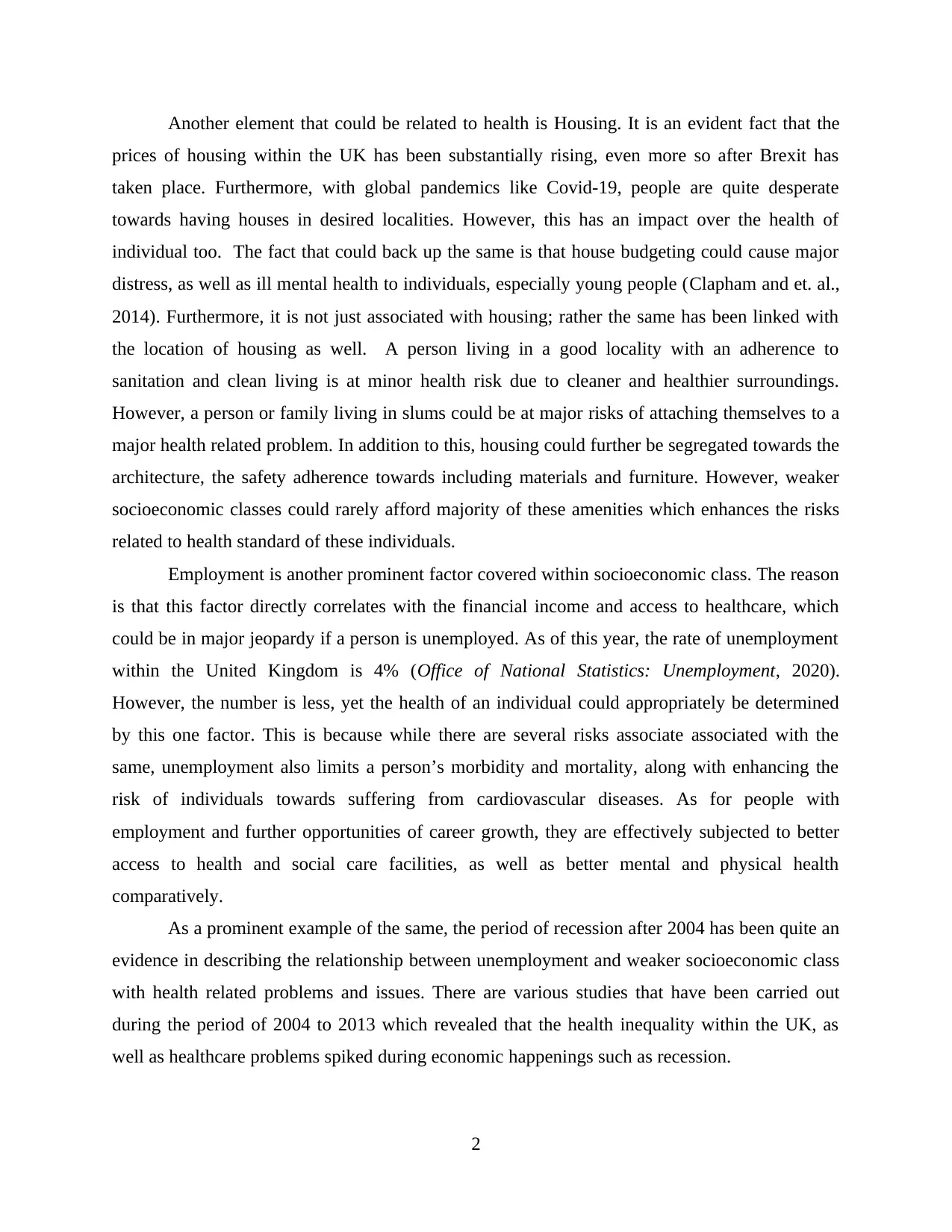
Another element that could be related to health is Housing. It is an evident fact that the
prices of housing within the UK has been substantially rising, even more so after Brexit has
taken place. Furthermore, with global pandemics like Covid-19, people are quite desperate
towards having houses in desired localities. However, this has an impact over the health of
individual too. The fact that could back up the same is that house budgeting could cause major
distress, as well as ill mental health to individuals, especially young people (Clapham and et. al.,
2014). Furthermore, it is not just associated with housing; rather the same has been linked with
the location of housing as well. A person living in a good locality with an adherence to
sanitation and clean living is at minor health risk due to cleaner and healthier surroundings.
However, a person or family living in slums could be at major risks of attaching themselves to a
major health related problem. In addition to this, housing could further be segregated towards the
architecture, the safety adherence towards including materials and furniture. However, weaker
socioeconomic classes could rarely afford majority of these amenities which enhances the risks
related to health standard of these individuals.
Employment is another prominent factor covered within socioeconomic class. The reason
is that this factor directly correlates with the financial income and access to healthcare, which
could be in major jeopardy if a person is unemployed. As of this year, the rate of unemployment
within the United Kingdom is 4% (Office of National Statistics: Unemployment, 2020).
However, the number is less, yet the health of an individual could appropriately be determined
by this one factor. This is because while there are several risks associate associated with the
same, unemployment also limits a person’s morbidity and mortality, along with enhancing the
risk of individuals towards suffering from cardiovascular diseases. As for people with
employment and further opportunities of career growth, they are effectively subjected to better
access to health and social care facilities, as well as better mental and physical health
comparatively.
As a prominent example of the same, the period of recession after 2004 has been quite an
evidence in describing the relationship between unemployment and weaker socioeconomic class
with health related problems and issues. There are various studies that have been carried out
during the period of 2004 to 2013 which revealed that the health inequality within the UK, as
well as healthcare problems spiked during economic happenings such as recession.
2
prices of housing within the UK has been substantially rising, even more so after Brexit has
taken place. Furthermore, with global pandemics like Covid-19, people are quite desperate
towards having houses in desired localities. However, this has an impact over the health of
individual too. The fact that could back up the same is that house budgeting could cause major
distress, as well as ill mental health to individuals, especially young people (Clapham and et. al.,
2014). Furthermore, it is not just associated with housing; rather the same has been linked with
the location of housing as well. A person living in a good locality with an adherence to
sanitation and clean living is at minor health risk due to cleaner and healthier surroundings.
However, a person or family living in slums could be at major risks of attaching themselves to a
major health related problem. In addition to this, housing could further be segregated towards the
architecture, the safety adherence towards including materials and furniture. However, weaker
socioeconomic classes could rarely afford majority of these amenities which enhances the risks
related to health standard of these individuals.
Employment is another prominent factor covered within socioeconomic class. The reason
is that this factor directly correlates with the financial income and access to healthcare, which
could be in major jeopardy if a person is unemployed. As of this year, the rate of unemployment
within the United Kingdom is 4% (Office of National Statistics: Unemployment, 2020).
However, the number is less, yet the health of an individual could appropriately be determined
by this one factor. This is because while there are several risks associate associated with the
same, unemployment also limits a person’s morbidity and mortality, along with enhancing the
risk of individuals towards suffering from cardiovascular diseases. As for people with
employment and further opportunities of career growth, they are effectively subjected to better
access to health and social care facilities, as well as better mental and physical health
comparatively.
As a prominent example of the same, the period of recession after 2004 has been quite an
evidence in describing the relationship between unemployment and weaker socioeconomic class
with health related problems and issues. There are various studies that have been carried out
during the period of 2004 to 2013 which revealed that the health inequality within the UK, as
well as healthcare problems spiked during economic happenings such as recession.
2
Paraphrase This Document
Need a fresh take? Get an instant paraphrase of this document with our AI Paraphraser
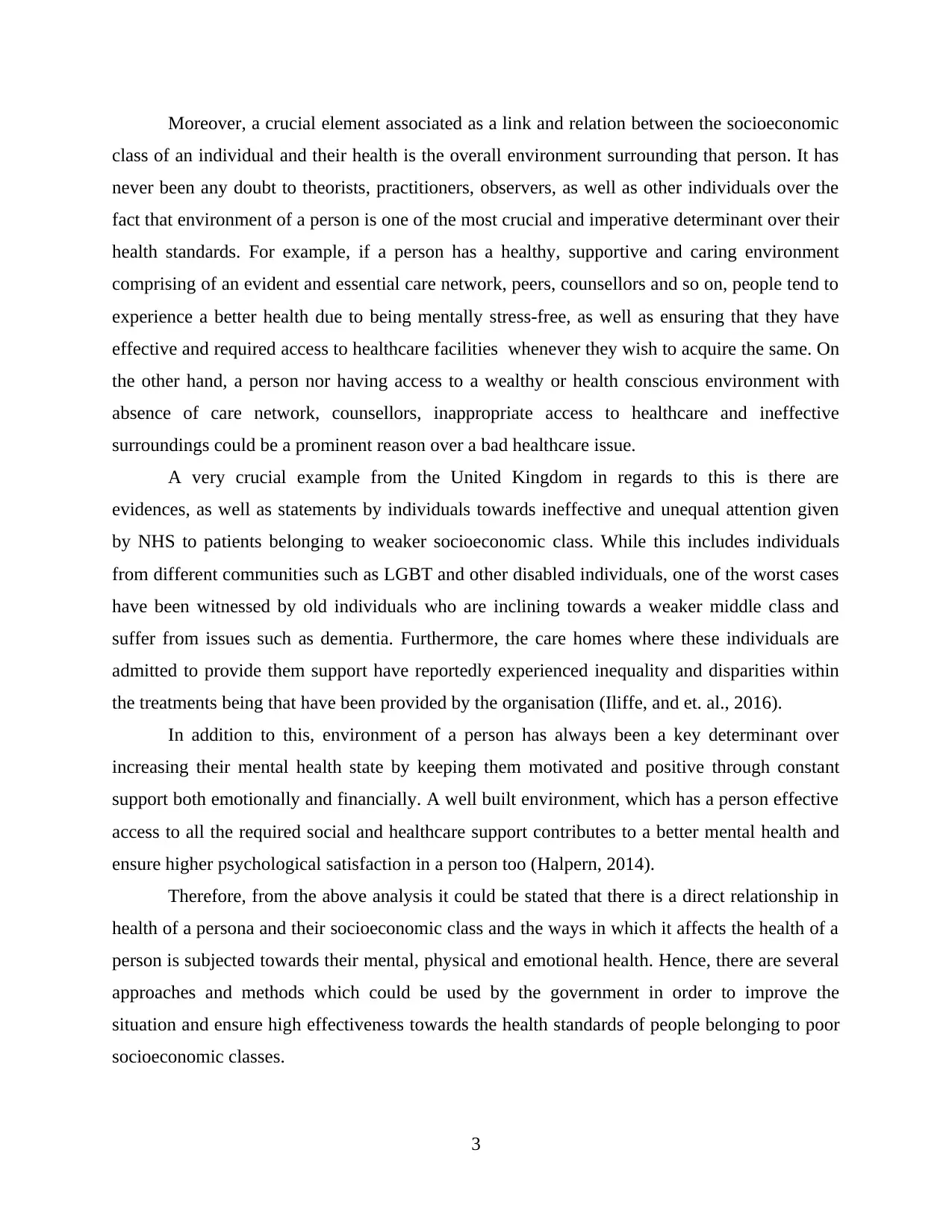
Moreover, a crucial element associated as a link and relation between the socioeconomic
class of an individual and their health is the overall environment surrounding that person. It has
never been any doubt to theorists, practitioners, observers, as well as other individuals over the
fact that environment of a person is one of the most crucial and imperative determinant over their
health standards. For example, if a person has a healthy, supportive and caring environment
comprising of an evident and essential care network, peers, counsellors and so on, people tend to
experience a better health due to being mentally stress-free, as well as ensuring that they have
effective and required access to healthcare facilities whenever they wish to acquire the same. On
the other hand, a person nor having access to a wealthy or health conscious environment with
absence of care network, counsellors, inappropriate access to healthcare and ineffective
surroundings could be a prominent reason over a bad healthcare issue.
A very crucial example from the United Kingdom in regards to this is there are
evidences, as well as statements by individuals towards ineffective and unequal attention given
by NHS to patients belonging to weaker socioeconomic class. While this includes individuals
from different communities such as LGBT and other disabled individuals, one of the worst cases
have been witnessed by old individuals who are inclining towards a weaker middle class and
suffer from issues such as dementia. Furthermore, the care homes where these individuals are
admitted to provide them support have reportedly experienced inequality and disparities within
the treatments being that have been provided by the organisation (Iliffe, and et. al., 2016).
In addition to this, environment of a person has always been a key determinant over
increasing their mental health state by keeping them motivated and positive through constant
support both emotionally and financially. A well built environment, which has a person effective
access to all the required social and healthcare support contributes to a better mental health and
ensure higher psychological satisfaction in a person too (Halpern, 2014).
Therefore, from the above analysis it could be stated that there is a direct relationship in
health of a persona and their socioeconomic class and the ways in which it affects the health of a
person is subjected towards their mental, physical and emotional health. Hence, there are several
approaches and methods which could be used by the government in order to improve the
situation and ensure high effectiveness towards the health standards of people belonging to poor
socioeconomic classes.
3
class of an individual and their health is the overall environment surrounding that person. It has
never been any doubt to theorists, practitioners, observers, as well as other individuals over the
fact that environment of a person is one of the most crucial and imperative determinant over their
health standards. For example, if a person has a healthy, supportive and caring environment
comprising of an evident and essential care network, peers, counsellors and so on, people tend to
experience a better health due to being mentally stress-free, as well as ensuring that they have
effective and required access to healthcare facilities whenever they wish to acquire the same. On
the other hand, a person nor having access to a wealthy or health conscious environment with
absence of care network, counsellors, inappropriate access to healthcare and ineffective
surroundings could be a prominent reason over a bad healthcare issue.
A very crucial example from the United Kingdom in regards to this is there are
evidences, as well as statements by individuals towards ineffective and unequal attention given
by NHS to patients belonging to weaker socioeconomic class. While this includes individuals
from different communities such as LGBT and other disabled individuals, one of the worst cases
have been witnessed by old individuals who are inclining towards a weaker middle class and
suffer from issues such as dementia. Furthermore, the care homes where these individuals are
admitted to provide them support have reportedly experienced inequality and disparities within
the treatments being that have been provided by the organisation (Iliffe, and et. al., 2016).
In addition to this, environment of a person has always been a key determinant over
increasing their mental health state by keeping them motivated and positive through constant
support both emotionally and financially. A well built environment, which has a person effective
access to all the required social and healthcare support contributes to a better mental health and
ensure higher psychological satisfaction in a person too (Halpern, 2014).
Therefore, from the above analysis it could be stated that there is a direct relationship in
health of a persona and their socioeconomic class and the ways in which it affects the health of a
person is subjected towards their mental, physical and emotional health. Hence, there are several
approaches and methods which could be used by the government in order to improve the
situation and ensure high effectiveness towards the health standards of people belonging to poor
socioeconomic classes.
3
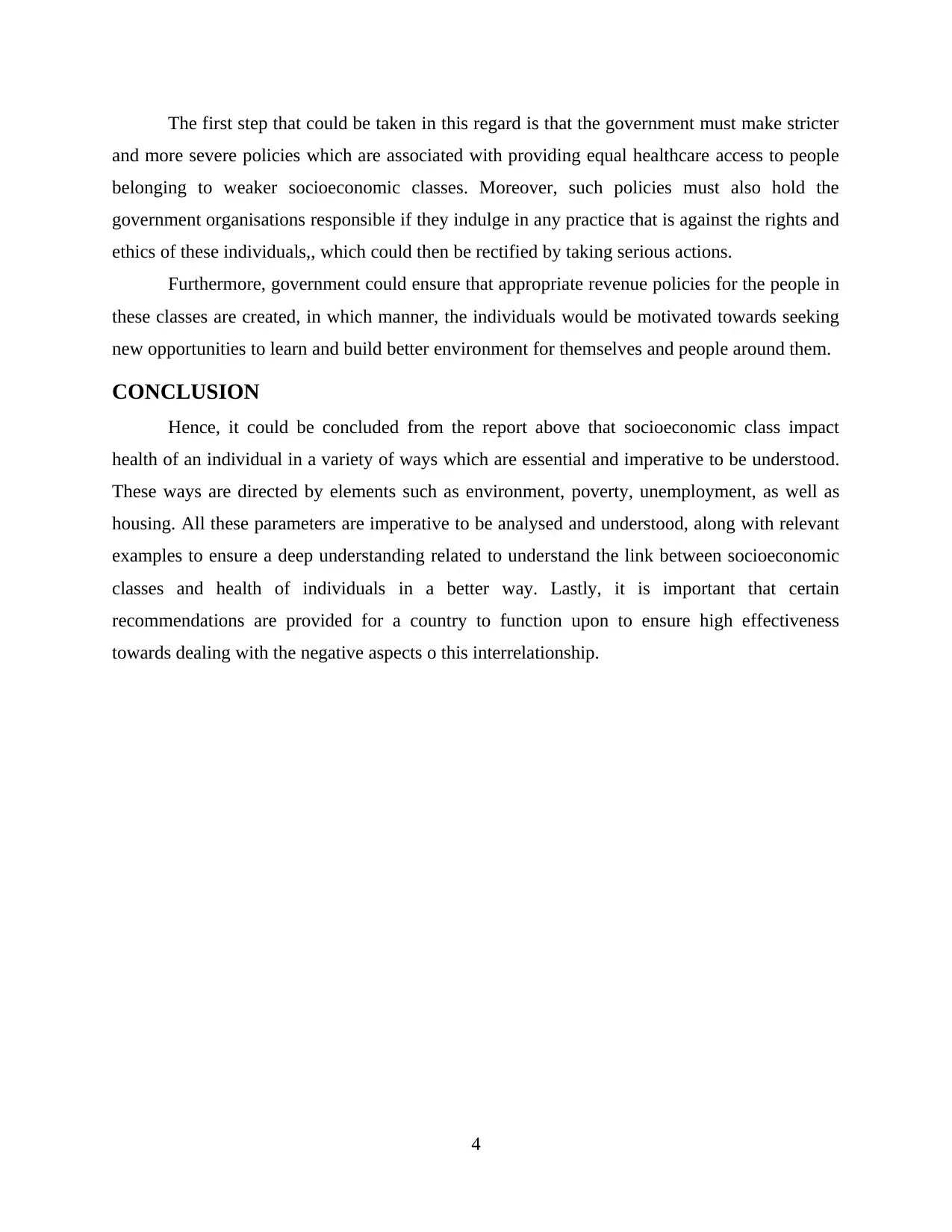
The first step that could be taken in this regard is that the government must make stricter
and more severe policies which are associated with providing equal healthcare access to people
belonging to weaker socioeconomic classes. Moreover, such policies must also hold the
government organisations responsible if they indulge in any practice that is against the rights and
ethics of these individuals,, which could then be rectified by taking serious actions.
Furthermore, government could ensure that appropriate revenue policies for the people in
these classes are created, in which manner, the individuals would be motivated towards seeking
new opportunities to learn and build better environment for themselves and people around them.
CONCLUSION
Hence, it could be concluded from the report above that socioeconomic class impact
health of an individual in a variety of ways which are essential and imperative to be understood.
These ways are directed by elements such as environment, poverty, unemployment, as well as
housing. All these parameters are imperative to be analysed and understood, along with relevant
examples to ensure a deep understanding related to understand the link between socioeconomic
classes and health of individuals in a better way. Lastly, it is important that certain
recommendations are provided for a country to function upon to ensure high effectiveness
towards dealing with the negative aspects o this interrelationship.
4
and more severe policies which are associated with providing equal healthcare access to people
belonging to weaker socioeconomic classes. Moreover, such policies must also hold the
government organisations responsible if they indulge in any practice that is against the rights and
ethics of these individuals,, which could then be rectified by taking serious actions.
Furthermore, government could ensure that appropriate revenue policies for the people in
these classes are created, in which manner, the individuals would be motivated towards seeking
new opportunities to learn and build better environment for themselves and people around them.
CONCLUSION
Hence, it could be concluded from the report above that socioeconomic class impact
health of an individual in a variety of ways which are essential and imperative to be understood.
These ways are directed by elements such as environment, poverty, unemployment, as well as
housing. All these parameters are imperative to be analysed and understood, along with relevant
examples to ensure a deep understanding related to understand the link between socioeconomic
classes and health of individuals in a better way. Lastly, it is important that certain
recommendations are provided for a country to function upon to ensure high effectiveness
towards dealing with the negative aspects o this interrelationship.
4
⊘ This is a preview!⊘
Do you want full access?
Subscribe today to unlock all pages.

Trusted by 1+ million students worldwide
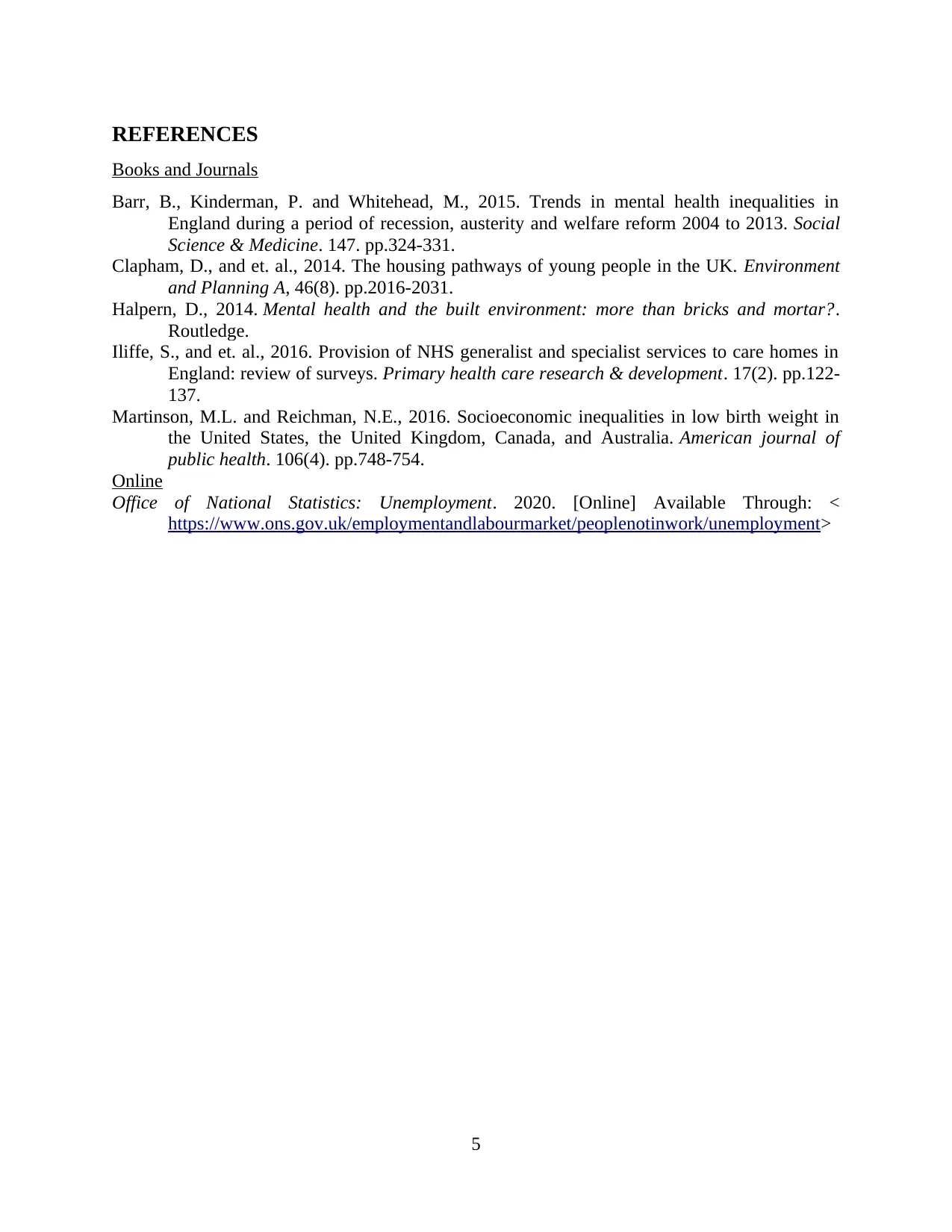
REFERENCES
Books and Journals
Barr, B., Kinderman, P. and Whitehead, M., 2015. Trends in mental health inequalities in
England during a period of recession, austerity and welfare reform 2004 to 2013. Social
Science & Medicine. 147. pp.324-331.
Clapham, D., and et. al., 2014. The housing pathways of young people in the UK. Environment
and Planning A, 46(8). pp.2016-2031.
Halpern, D., 2014. Mental health and the built environment: more than bricks and mortar?.
Routledge.
Iliffe, S., and et. al., 2016. Provision of NHS generalist and specialist services to care homes in
England: review of surveys. Primary health care research & development. 17(2). pp.122-
137.
Martinson, M.L. and Reichman, N.E., 2016. Socioeconomic inequalities in low birth weight in
the United States, the United Kingdom, Canada, and Australia. American journal of
public health. 106(4). pp.748-754.
Online
Office of National Statistics: Unemployment. 2020. [Online] Available Through: <
https://www.ons.gov.uk/employmentandlabourmarket/peoplenotinwork/unemployment>
5
Books and Journals
Barr, B., Kinderman, P. and Whitehead, M., 2015. Trends in mental health inequalities in
England during a period of recession, austerity and welfare reform 2004 to 2013. Social
Science & Medicine. 147. pp.324-331.
Clapham, D., and et. al., 2014. The housing pathways of young people in the UK. Environment
and Planning A, 46(8). pp.2016-2031.
Halpern, D., 2014. Mental health and the built environment: more than bricks and mortar?.
Routledge.
Iliffe, S., and et. al., 2016. Provision of NHS generalist and specialist services to care homes in
England: review of surveys. Primary health care research & development. 17(2). pp.122-
137.
Martinson, M.L. and Reichman, N.E., 2016. Socioeconomic inequalities in low birth weight in
the United States, the United Kingdom, Canada, and Australia. American journal of
public health. 106(4). pp.748-754.
Online
Office of National Statistics: Unemployment. 2020. [Online] Available Through: <
https://www.ons.gov.uk/employmentandlabourmarket/peoplenotinwork/unemployment>
5
1 out of 7
Related Documents
Your All-in-One AI-Powered Toolkit for Academic Success.
+13062052269
info@desklib.com
Available 24*7 on WhatsApp / Email
![[object Object]](/_next/static/media/star-bottom.7253800d.svg)
Unlock your academic potential
Copyright © 2020–2025 A2Z Services. All Rights Reserved. Developed and managed by ZUCOL.




